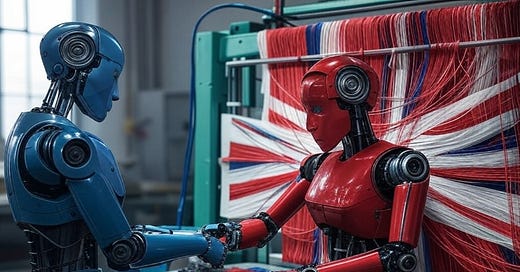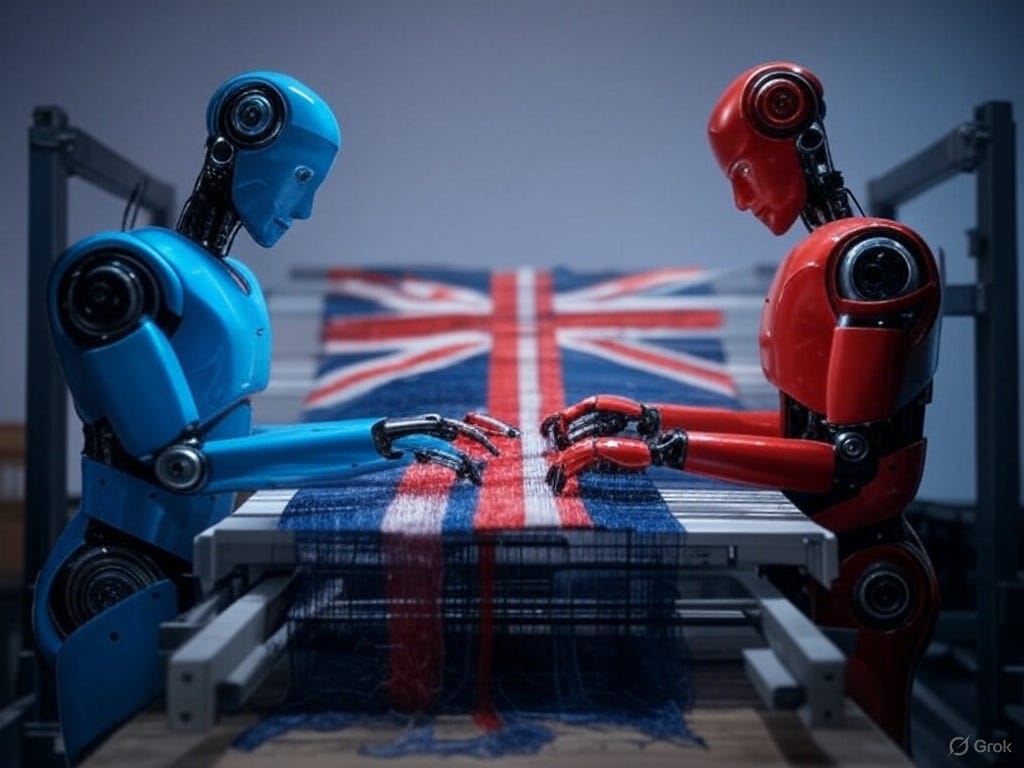TecC 06 - The First Great Acceleration: The Birth of Industry
The Revolution that changed Everything
In previous episodes I have laid out the broad theory of the technocentric paradigm including the ‘duonomy’ therein - artefactual and institutional, which I touched upon in light of the historical development of technology as a whole. Let’s next jump into the first great acceleration, where, for the first time in all human history, these forces came together to enable the most consequential revolution of them all!
If you think my reference to The First Great Acceleration sounds familiar, that’s because I mentioned it in TecC 04. There are other important developments which also need to be looked into before getting into the intricacies of the said revolution, both of which I intend to do in considerable detail, as they’re amongst the most important and illustrative parts of the technocentric story. But we’ll come to this in later episodes instead of cramming it all here in this one - here we’ll chalk a broad outline of this to serve as a case study to bring home the rather more theoretical points made in the previous couple of episodes.
This broad outline has another purpose - it links to a bunch of vital topics of economic importance that I have or will be mentioning elsewhere across articles and series. This economic angle is also crucial to understanding the world, and in particular technological progress, and these other articles may be part of a series specifically devoted to taking an economic perspective. These links or references should enable you to switch between these different paradigms and thus gain an even more robust understanding of all of this, in line with my original promise in my introduction.
From Small Beginnings to Glorious Growth
In 1588, Great Britain was still a small insignificant island at the North-Western corner of Europe, itself not particularly distinguished technologically or economically from any other continent or region in the Old World.
But you could say that year was a turning point in history: England, the largest kingdom on the island, but still somewhat weak and vulnerable compared to the two larger and more powerful states in Europe, had just defeated the most powerful of them - this is the defeat of the hitherto-thought-invincible Spanish Armada,1 a fleet of 130 ships sent to conquer2 and once and for all subjugate Queen Elizabeth I3 and her Protestant realm, a thorn in Catholic Spain’s imperial ambitions across the Atlantic.
That this was a conflict between Catholic4 and Protestant powers is of significance because beyond being the bone of contention in the power politics of the day in Western Europe, that on-the-surface-religious dichotomy would underpin some rather fundamental institutional differences that will in due course turn out as relevant to our technocentric story.
So fast-forward to Great Britain 1688, and after a series of convulsions including civil war, regicide and a short-lived military-led republican dictatorship, the polity based in London undergoes a series of institutional changes that culminate in the Glorious Revolution. No, this is not the revolution I was referring to, but from an institutional sense, you could say, this is where it started: this, is the beginning of the beginning!
A Fertile Complement
As a result, by 1714 the newly United Kingdom of Great Britain had emerged as a leading global power with unmatched naval might, a global empire, and crucially for our current story, a series of institutions, which in conjunct with the peace, stability and complementarity on the island following Union between England and Scotland, laid the ground for this great technological revolution.5
The political developments here may or may not be of interest to you, but I’ll reiterate the importance of the institutional developments (which I’ve promised to elaborate on when we get into the details in later episodes where relevant) because many aspects of them are part of the ‘institutional technology’ I’ve outlined in this series.
Capturing Energy
For thousands, if not tens or hundreds of thousands, of years, patterns in production - which I’ve touched upon when introducing what I’ve called the Production Equation (Input + Processing = Output), remained pretty much unchanged. Productivity - the measure of this output, remained more or less unchanged. And then there was this sudden spurt. The most important part of this story is, as hinted in TecC 04, the ability to harness energy by using steam power.
There were early attempts at harnessing the power of steam, the most notable being that of Thomas Newcomen6 in the early 1700s leading to its widespread use in that form for over half a century. In general, however, it’s the improvements effected by James Watt7 in the latter part of the 1700s - Watt’s steam engine, that is seen as epitomizing this energy revolution.8 (When we discuss the intricate details of these, we’ll see how technological innovation can be incremental and as carried out by several innovators rather than the sudden eureka moment that we like to entertain as part of a romantic version of ‘the great inventor’!)
However, while capturing energy was at the heart of this revolution in Britain in the 1700s, there are many other technological developments that were instrumental in making this happen.
Weaving the Web
It wouldn’t do justice to any of the myriad of specific developments and milestones to simply devote a paragraph or two each, so at this point in the series, I’ll just list them out: there was intensive mechanization, in particular in the area of textile manufacturing, so much so that the word ‘manufacturing’ has since become a misnomer!9 So yes, that led to the development of ‘factories’, where clothing was, shall we say ‘factured’ with far greater productivity than could be manu.. factured: made manually, by hand!
Another key element in the energy story was coal mining, and closely connected to this was iron production (more coal/energy - more iron-making!) Related to this was a revolution in transportation technology, which started off as rails to move coal out of the mines, but the presence of many rivers in Great Britain and the manic development of canals around them also helped!
It’s not hard to see how each of these innovations helped the other and how they all reinforced one another. Likewise, developments in legal systems, such as intellectual property and corporate law, financial systems such as banking, insurance and capital markets, all contributed to this effervescence. Some of these institutional developments, as we shall see, are related to the somewhat particular set of circumstances that led to the Glorious Revolution already mentioned.
Weft and Warp at Work
Thus it was this unique combination, in our technocentric parlance, of artefactual and institutional technological developments - the weft and the warp that intertwined to make this a revolution - for this was the first great acceleration, an accumulation, an amalgamation, that changed everything! It was the birth of industry: a means of production far greater and far grander than anything that came before, and one that would continue to accelerate.
This miracle from Britain is what we call the Industrial Revolution, a turning point in the history of technology, and thus humanity. It was, we can safely say from our technocentric vantage point, the greatest revolution in all humanity, because it changed everything! There have been other revolutions and breakthroughs since this, many arguably of a bigger scale and more global impact, but this was the start of the acceleration, the accumulation, the accretion - to put it Newtonianly, this was the largest and greatest giant shoulder later achievements stood upon!
There will be more to say, as things only get more interesting from here on.
Voice and images generated by AI
The word ‘armada’ is simply Spanish for ‘armed’ - the full name of the Spanish Armada translates (per Wikipedia) to ‘Great and Most Fortunate Navy’!
One joke in England after the defeat of the Armada was a twist to Caesar’s triumphant and well-known proclamation, into: ‘venit, vidit, fugit’ - “it came, it saw, it ran away” !
1533 - 1603, daughter of Henry VIII of England and his second wife Anne Boleyn
Mainly France and Spain, both significantly larger than England demographically and economically in 1588
Wales, the other great nation on the island of Great Britain, was already deeply integrated with England since Tudor times
1664 -1729, born in Devon, England, United Kingdom
1736 - 1819, born in Greenock, Scotland, United Kingdom
James Watt is thus immortalized with ‘watt’ later becoming the unit of power
‘manu-’ is from the Latin ‘manus, -ūs’ “hand”, giving us a whole bunch of words from ‘manipulate’ to ‘manage’






Good style, great research, awesome writing! Waiting for your analysis of AI.
This was great, I look forward to more. Well done!